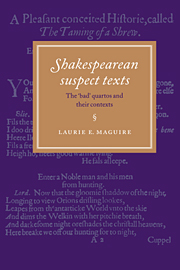7 - Diagnosing memorial reconstruction: the Poem, the Play, the Text
Published online by Cambridge University Press: 19 October 2009
Summary
Foul! No repetitions…
Foul! No synonyms!…
Foul! No non sequiturs.
Tom Stoppard, Rosencrantz and Guildenstern are DeadI am not so much concerned with discrediting this method as with trying to discover whether there may not be sound ways of using it.
H. T. PriceTHE POEM
With suspect texts containing between 757 and 3,416 lines of dialogue (the totals for A Yorkshire Tragedy and Q Richard 3, respectively), the Poem provides our largest catchment area of material for evaluation. This verbal matter can be affected by a number of agents: revising or indecisive authors, playbook annotators, actors, scribes, and compositors. The amorphous category of repetitions, for instance, which critics cite as strong evidence of memorial reconstruction, is easily attributable to all five of the above. How, then, do we distinguish a memorial repetition from any other?
REPETITION
External Echoes/Recollection
Harry Hoppe claimed to have identified twenty-four ‘true inter-play borrowings’ (also known as ‘echoes’, ‘parallels’, and ‘external recollections’) in Q1 Romeo and Juliet. All of his ‘borrowings’ come from Shakespearean texts, twenty of them from plays written in the same period as Romeo and Juliet (Richard 2, The Taming of the Shrew, 3 Henry 6, Titus Andronicus, The Two Gentlemen of Verona, and Richard 3); thus, the possibility of authorial self-borrowing is strong, and undermines any value Hoppe's parallels may have.
His parallels are of negligible value anyway; they contain proverbial phrases (e.g. The Merry Wives of Windsor: ‘we burn daylight’), or common sentiments (Richard 2: ‘And then be gone’) or refer to parallel situations (The Two Gentlemen of Verona: ‘a ladder quaintly made of cords’).
- Type
- Chapter
- Information
- Shakespearean Suspect TextsThe 'Bad' Quartos and their Contexts, pp. 159 - 226Publisher: Cambridge University PressPrint publication year: 1996

